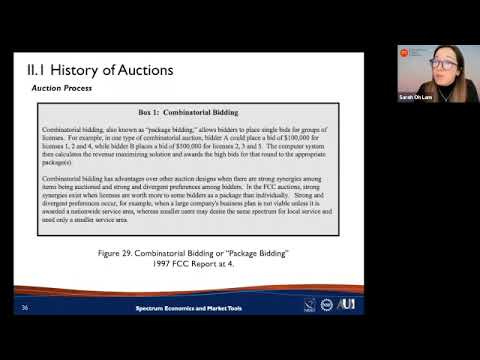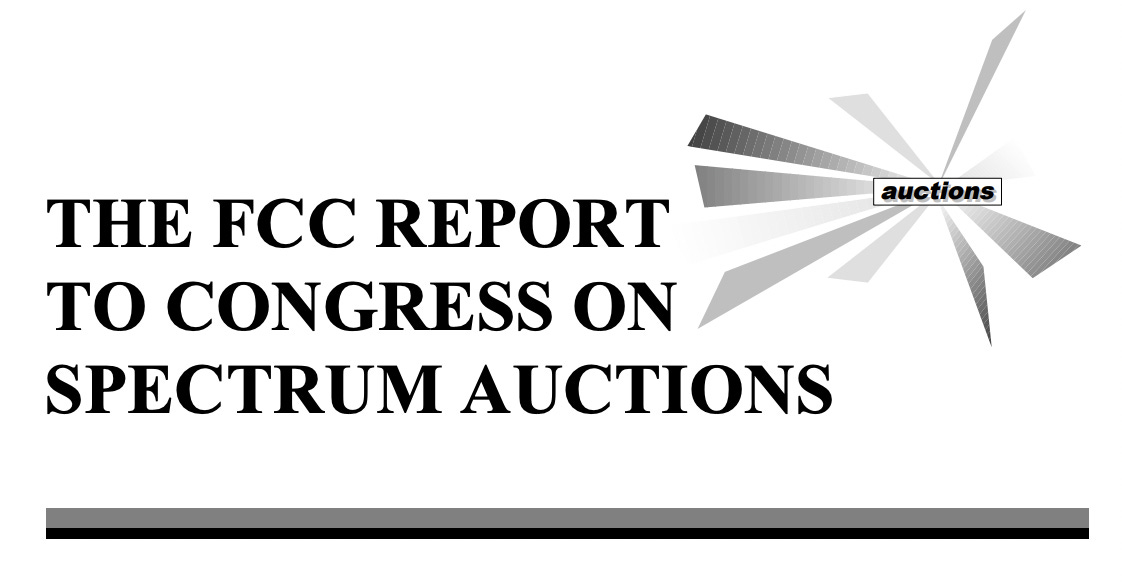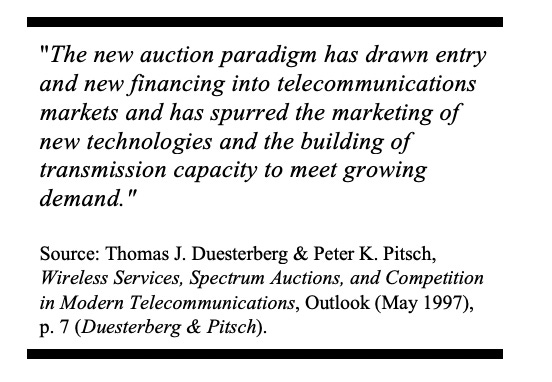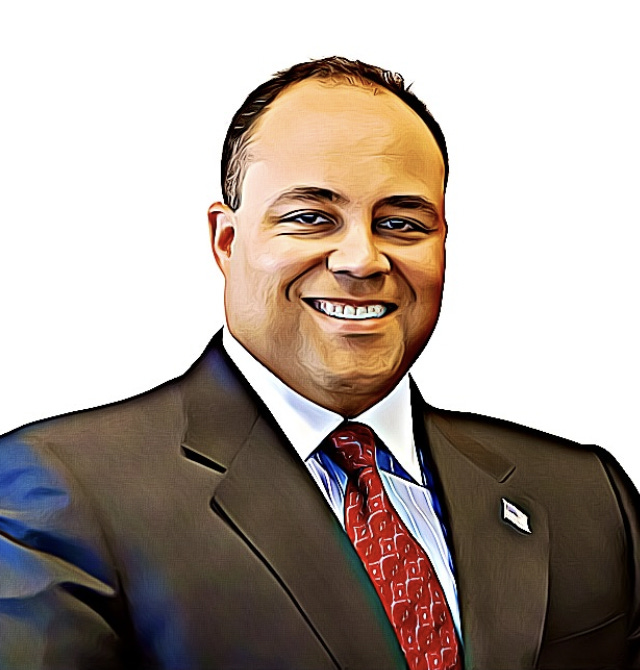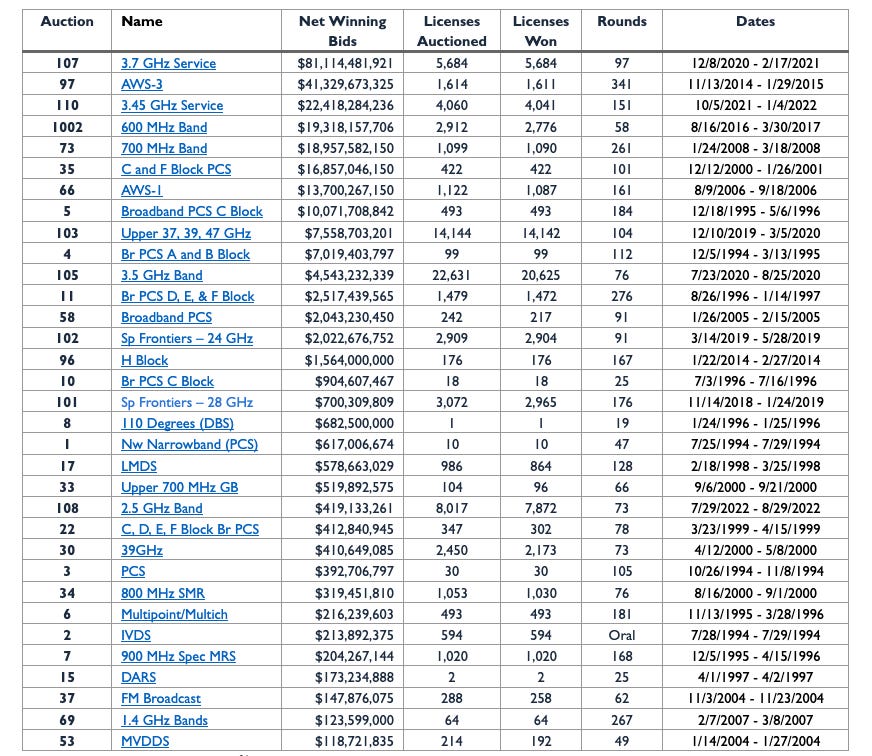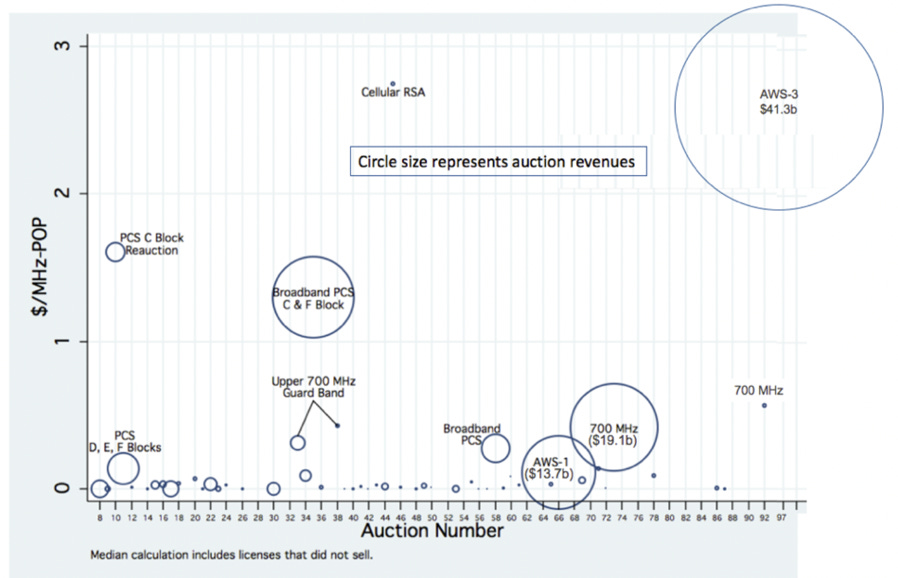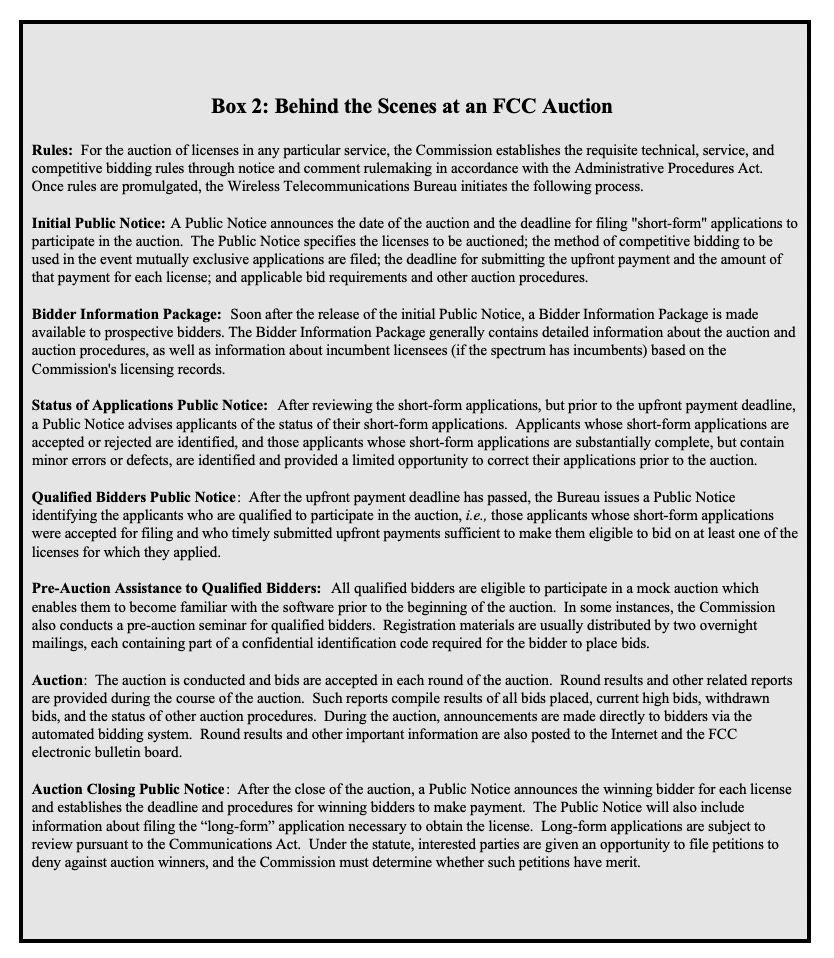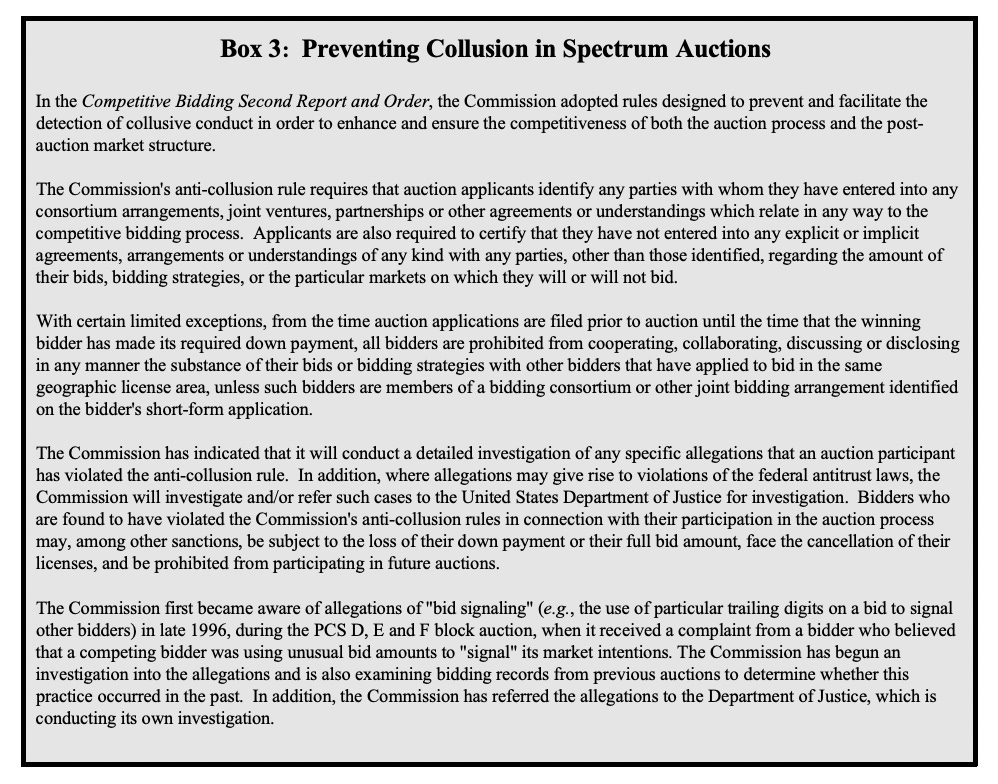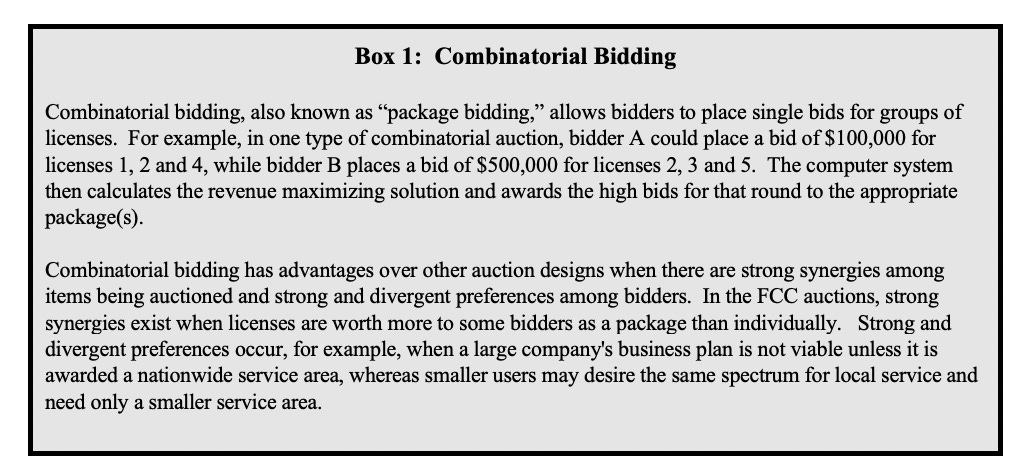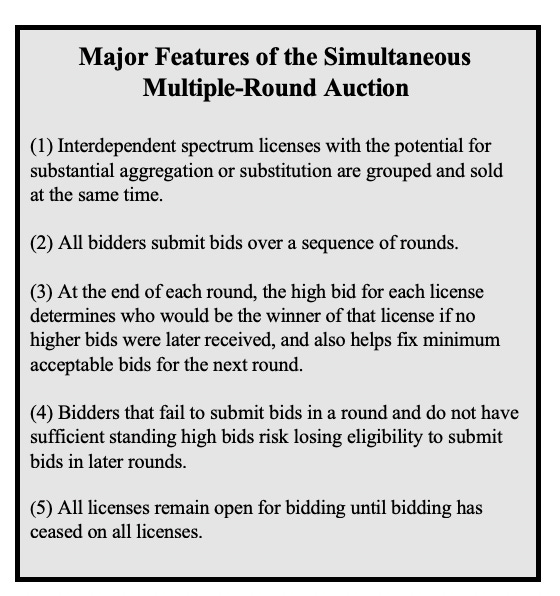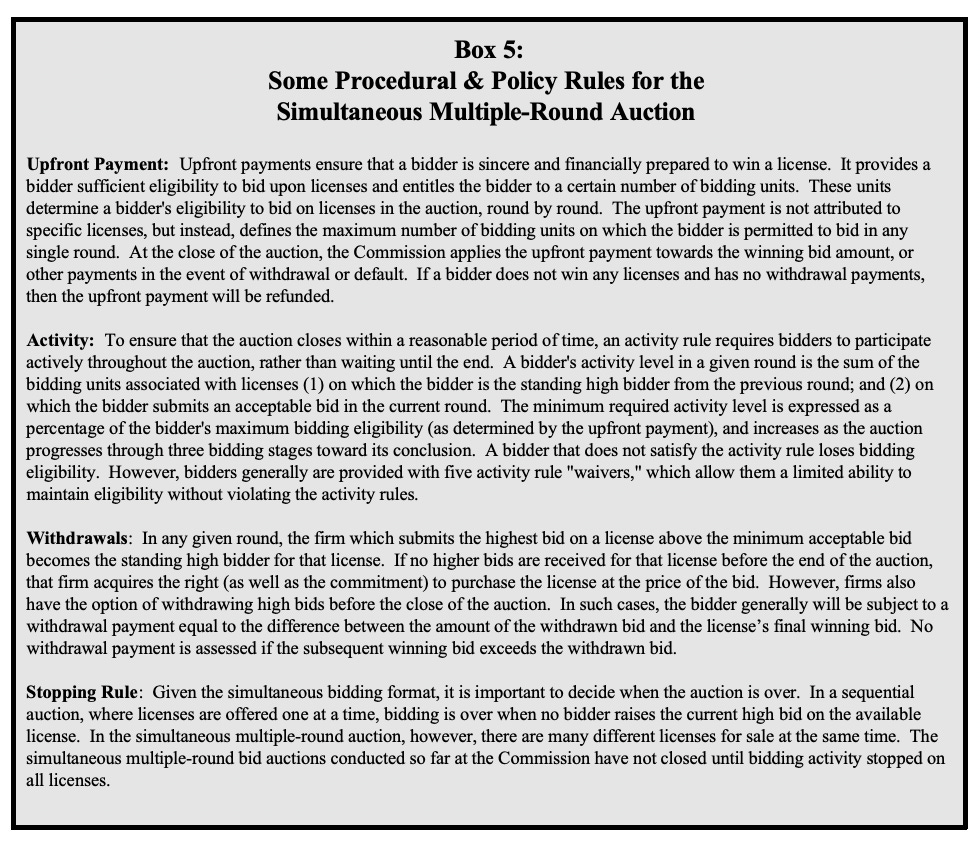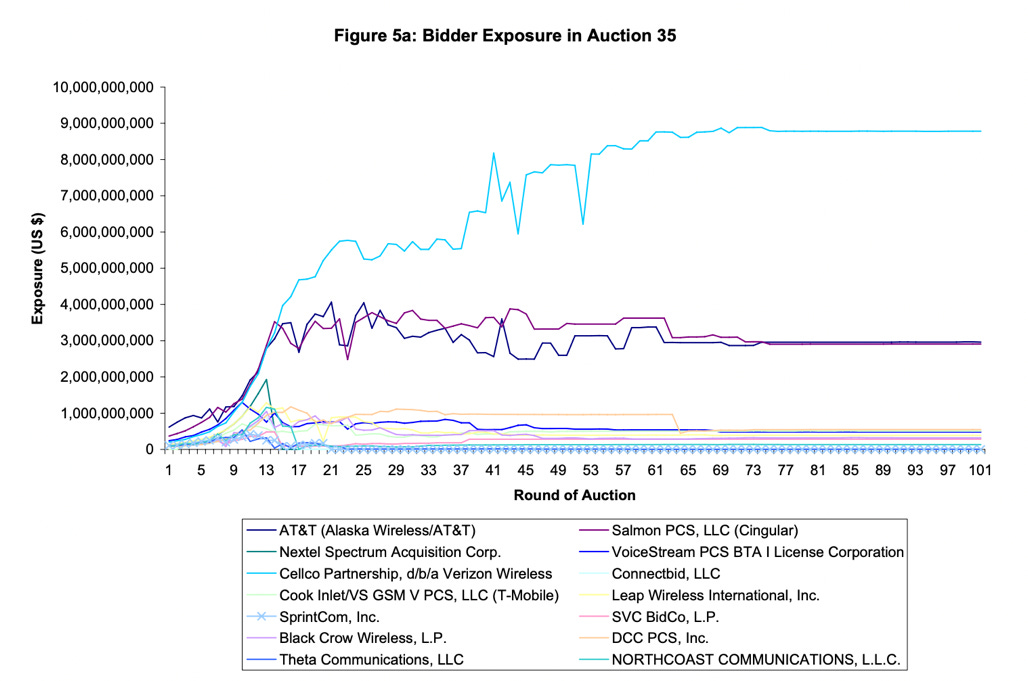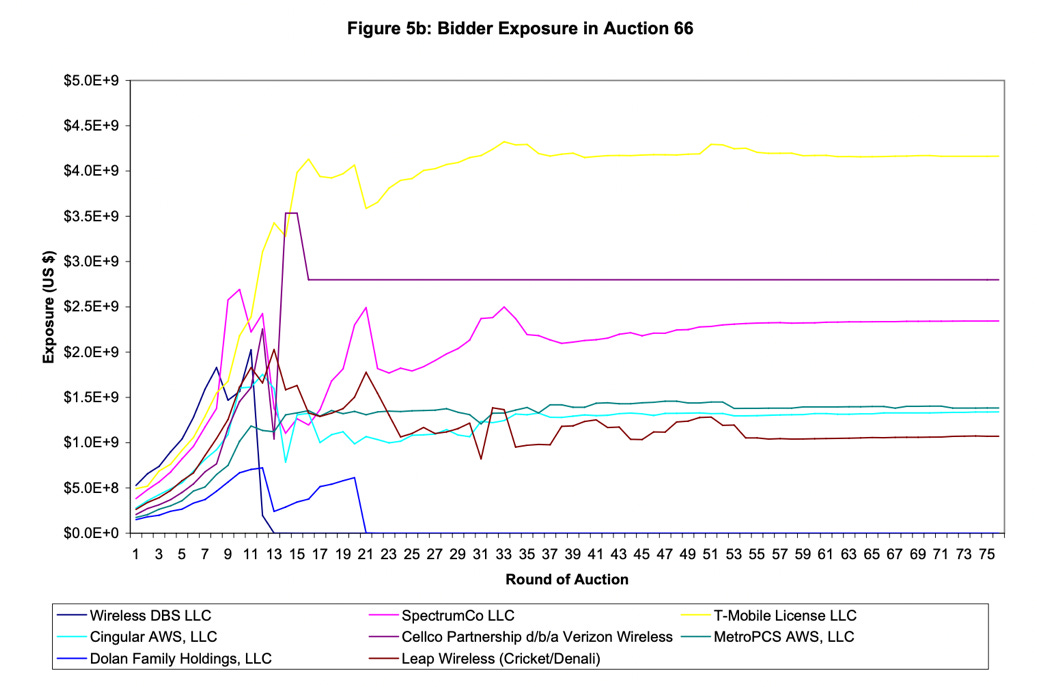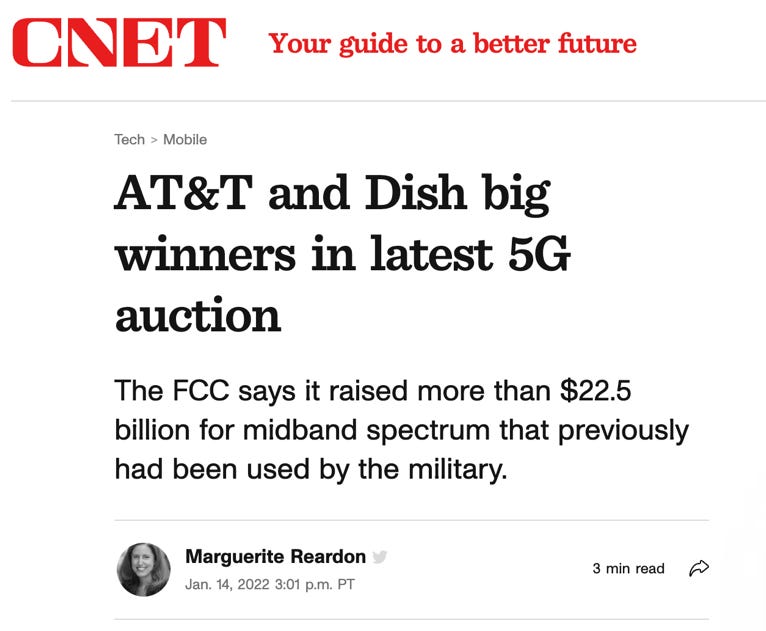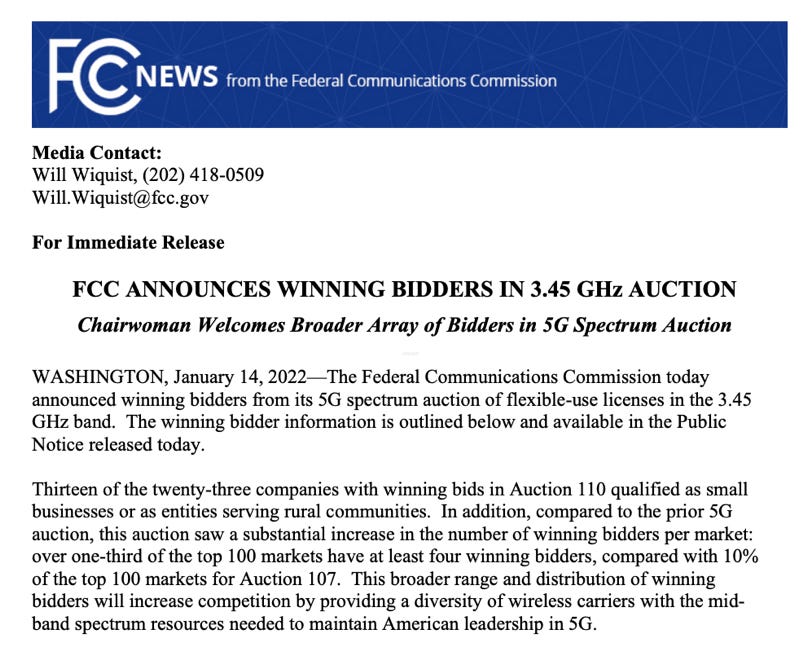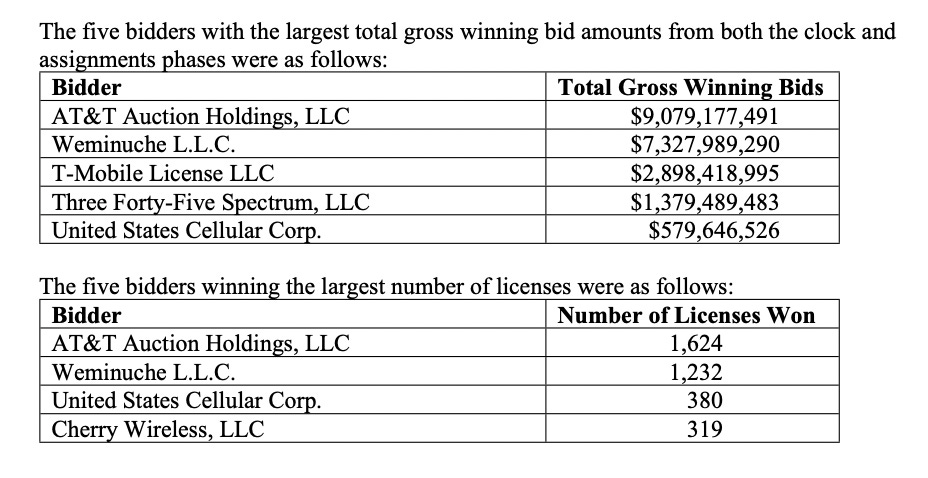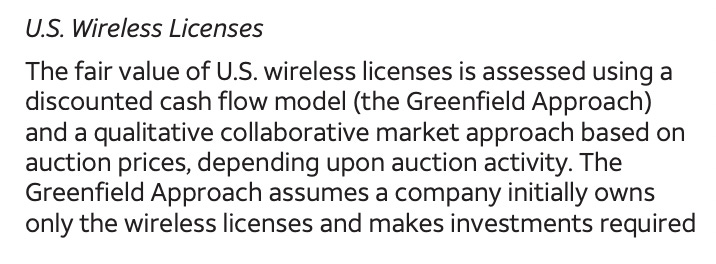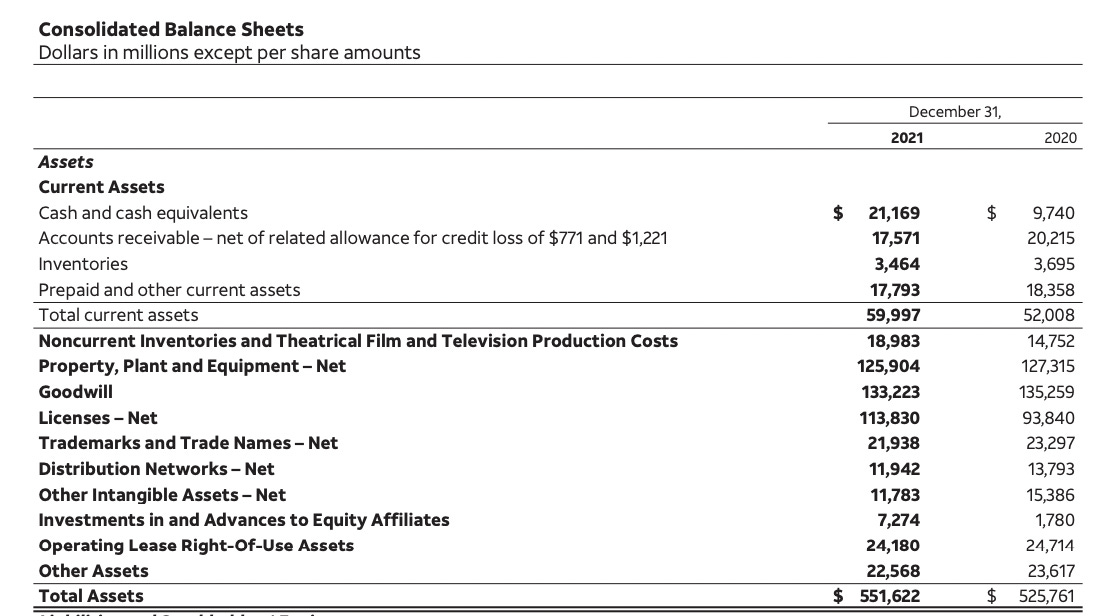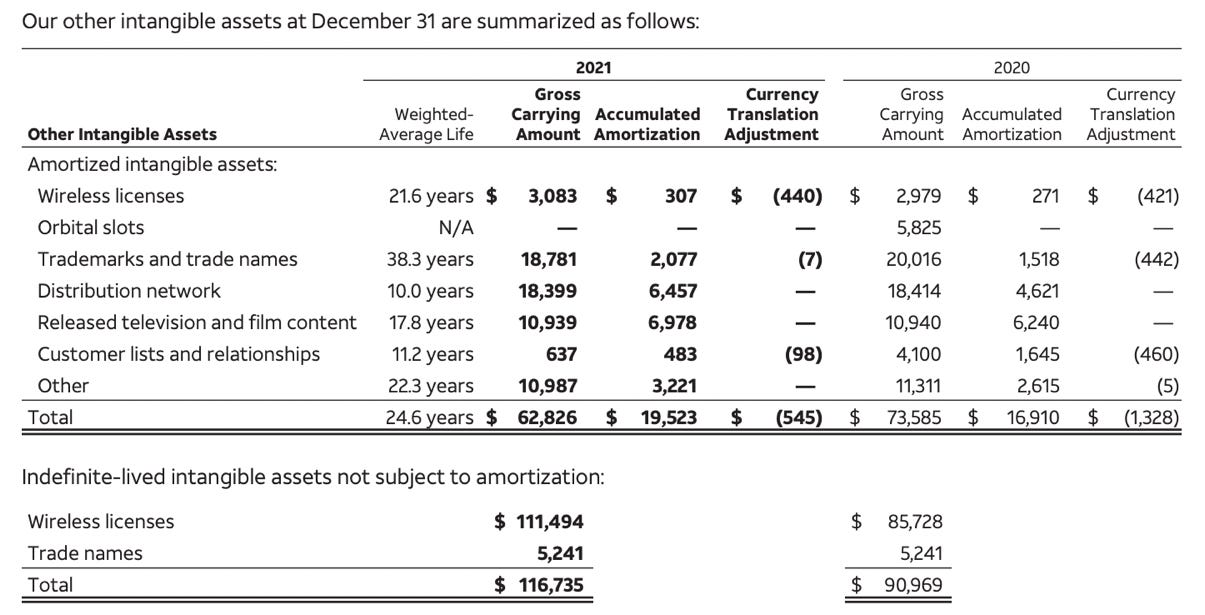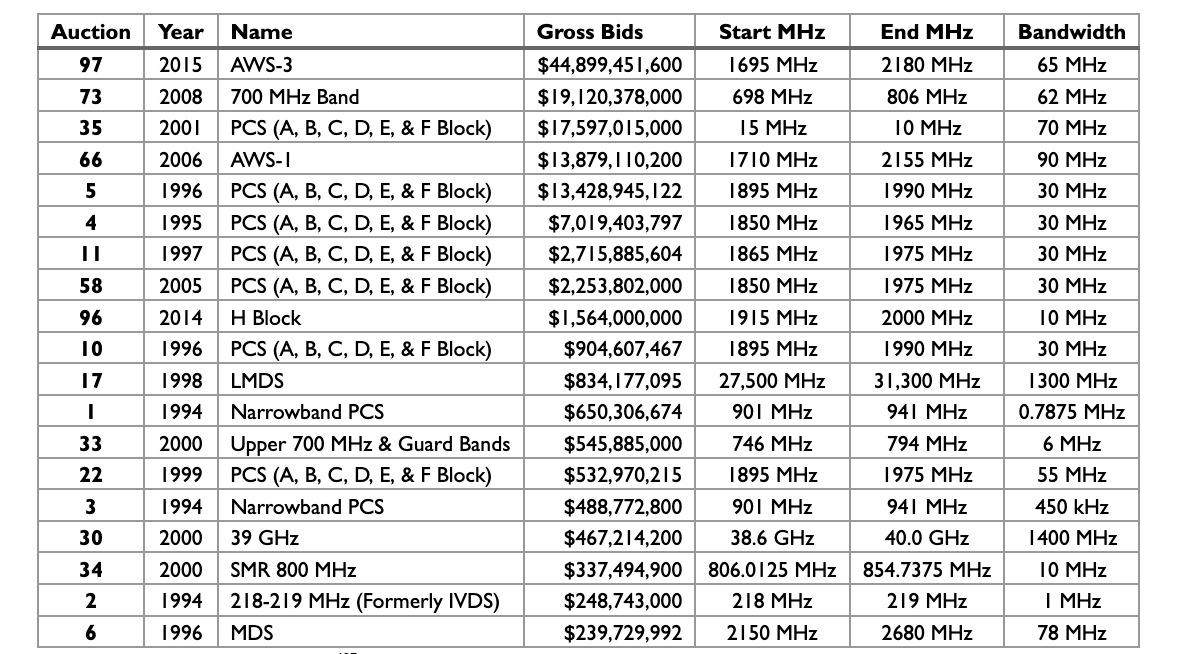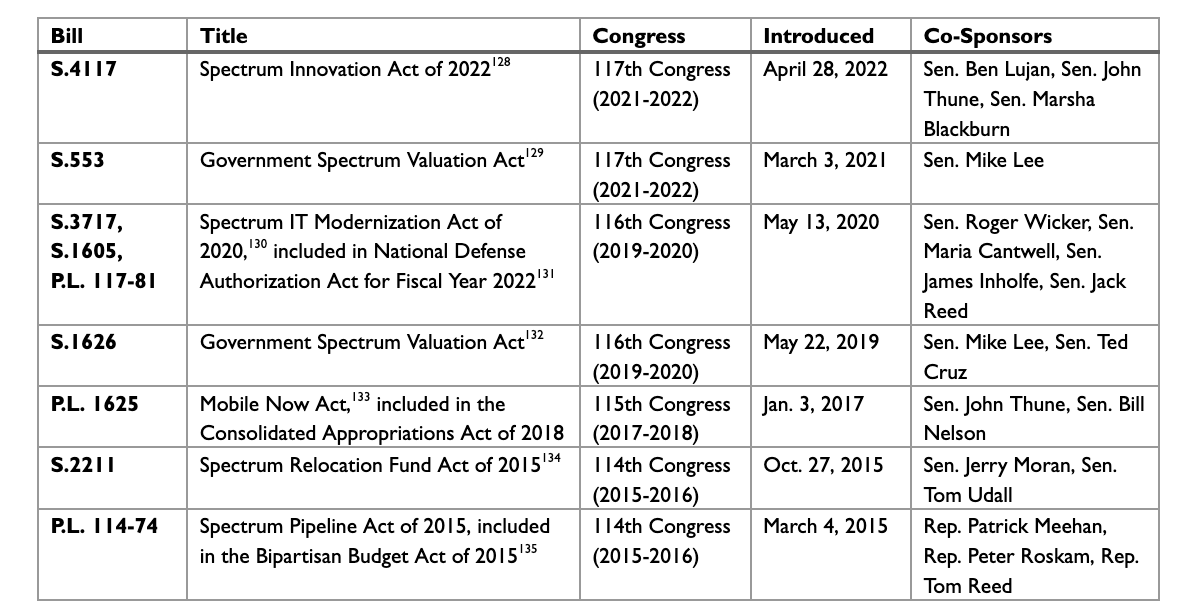Lecture 2: Spectrum Economics - History of Auctions and Valuation Methods
Spectrum Economics Primer - video series
Course Materials
Spectrum Economics
History of Auctions
Telecommunications Act of 1996
Spectrum auctions started in the United States in 1994 and were codified in the Telecommunications Act of 1996. Soon after the passage of the 1996 Telecom Act, the FCC Wireless Bureau released a report to Congress on spectrum auctions.
Figure 22. FCC Report to Congress in 1997 on Spectrum Auctions
The report gives a history of comparative hearings, lotteries, and newly approved, auctions. In 1993, Congress authorized the FCC to use auctions, and in the first 4 years of the new rule, over 4,300 licenses were awarded for $23 billion. In the words of two telecommunications attorneys and cited by the FCC Report, “[t]he new auction paradigm has drawn entry and new financing into telecommunications markets and has spurred the marketing of new technologies and the building of transmission capacity to meet growing demand.”
Figure 23. Quote from FCC Report to Congress on the New Auction Paradigm
Prior to this “new paradigm,” the FCC used comparative hearings to applicants to distribute spectrum. First-come, first-serve was the order of allocation unless a particular license had more than one applicant. In a manual, and time-consuming administrative process prior to automated auctions, regulators decided who to give spectrum licenses based on “public interest, convenience, or necessity” in a quasi-judicial forum. Lotteries were also used for assigning a broad range of licenses starting in 1981. The FCC was overwhelmed with pre-screening of spectrum applicants and by 1987, opened the lotteries up to all potential applicants, which led to the emergence of “application mills.”
Auctions were introduced in 1993 and rules governing auction structure by 1994. The FCC released its report to Congress on spectrum auctions and continued to auction new spectrum in the late 1990s and early 2000s that form the basis of national cellular networks. Since then, the FCC has conducted over 100 auctions to meet demand for licenses to use the radio spectrum for wireless communications.
Figure 24. William E. Kennard (D), Chairman of the FCC from Nov. 3, 1997 to Jan. 19, 2001
Figure 25. Michael K. Powell (R), Commissioner of the FCC from Nov. 3, 1997 to Mar. 17, 2005, and Chairman of the FCC from Jan. 22, 2001 to Mar. 15, 2005
Spectrum prices and the interest from commercial bidders for auctioned frequency bands shows the trend toward more economic value from the radio spectrum over time. Through auctions, large sums of money have been bid, but more importantly, far more economic value has been unlocked for wireless services that use the radio spectrum in novel and efficient ways.
Table 1. Completed Spectrum Auctions above $100M Net Winning Bids
Source: FCC, Auctions Summary
Figure 26. Early Auctions Compared to AWS-3 in Auction 97
Auction results from the first few auctions through Auction 97: AWS-3 in 2015 are shown in the figure. The predicted price for that spectrum was around $1.00 per MHz/pop, but ended up being $2.72 per MHz/pop for paired spectrum, which resulted in a $44 billion payout to the U.S. Treasury.
Running spectrum auctions involves legal and compliance procedures, the competitive bidding process is rather straightforward. Bidders bid up to their true values to win spectrum licenses, competing with other bidders to win the license based on private information. The FCC sets a specific auction design and particular rules for bidders. Auction theory and technical details come into play in order to mitigate the bidder strategies toward collusion. Combinatorial bidding and the simultaneous multiple-round auctions have been implemented in order to prevent inefficient outcomes.
Figure 27. How to Run an FCC Spectrum Auction
Figure 28. Collusion in Spectrum Auctions
Figure 29. Combinatorial Bidding or “Package Bidding”
Figure 30. Features of Simultaneous Multiple-Round Auction
Figure 31. Rules for Simultaneous Multiple-Round Auctions
These auction design choices have been developed over the years through observing bidding behavior in early spectrum auctions. Surprising results in certain auctions, such as the AWS-1 auction in summer of 2006, showed that one bidder’s strategic decisions to overcome limitations in the auction design may have allowed it to achieve a billion dollar discount to build a national network. Budget and “exposure problems” in this auction led to the development of package bidding which was implemented in later auctions. The mechanism design in response to these complex scenarios has led to advances in economic theory that has led to acknowledgment in Nobel Prize awards.
To briefly summarize these concepts, the “exposure problem” in a simultaneous ascending auction means that new entrants that need many licenses across the country are unable to predict the final prices for all the licenses they need to win to build a national network, and thus, cannot allocate their budgets well. This means that bidders tend to settle on prices according to their budgets, and it has been observed that bidders “may wish to manipulate the price paths so larger licenses reach their final prices earlier in the auction than smaller ones.”
By round 10 or 11 in the PCS auction, Auction 35, and the AWS-1 auction, Auction 66, according to Bulow, Levin, and Milgrom (2009), the exposure problem is observed rather early in the auction rounds. According to the authors, this gives a forecast of total prices in the final rounds. This led to early bidders to realize that high bids on some licenses relative to total budgets would result in discounted bids on smaller licenses. This understanding of exposure is explained as the cause of one bidder’s successful auction strategy in the AWS-1 auction, Auction 66.
Figure 32. Bidder Exposure in Auction 35 (Bulow, et al., 2009)
Figure 33. Bidder Exposure in Auction 66 (Bulow et al., 2009)
In the years since 2009, package bidding has been implemented in spectrum auctions to mitigate the exposure problem. Based on foundations discovered in these earlier auctions, the FCC has held larger and more complex auctions between 2010-2020 and 2020 to the present.
Recent Auctions
FCC Auction 107. Mid-band spectrum known as the “C-Band” was auctioned by the FCC in Auction 107 in early 2021.
FCC Auction 110. Mid-band spectrum was also auctioned off by the FCC in Auction 110 in early 2022. The spectrum band was 2.5 GHz to 3.5 GHz for mobile deployment of 5G.
Figure 34. Headline on Auction 110 Winners
Figure 35. Winning Bidders in 3.45 GHz Auction 110
Figure 36. Winning Bidders in 3.45 GHz Auction 110
These gross bids have increased into the tens of billions of dollars, which reveal the economic value and discounted cash flows expected from obtaining spectrum licenses on this valuable spectrum. The bidder’s exercise in forecasting how much a particular spectrum license should be worth depends on spectrum valuation methods that rely on different accounting methods and various sources of transaction data and estimates of future activity on the spectrum.
Spectrum Valuation Methods
Capital markets and telecom firms need to assess the value of spectrum licenses on their balance sheets and for purposes of bidding in spectrum auctions. This exercise depends on inputs of data and methods of forecasting future profitability and use of the spectrum licenses.
Indefinitely Lived Intangible Assets
Spectrum licenses are considered for financial reporting purposes, indefinitely lived intangible assets, governed by the Financial Accounting Standards Board (FASB) Accounting Standards Codification (ASC) Topic 820 on Fair Value Measurements and Disclosures. Companies that hold spectrum licenses are required to value the intangible assets on a regular basis because they are subject to impairment testing under FASB ASC 350-30-35 General Intangibles Other than Goodwill – Subsequent Measurement. In fact, Sprint in 2004 took a $1.2 billion write-down, or impairment loss, on its spectrum holdings in Multichannel Distribution Service.
But to do this valuation exercise, the valuation specialist needs to select a method to apply limited amounts of available data to determine a value for financial reports. Two common methods are the market approach or income approach.
The market approach, or “M&A” approach, uses transaction data from similar assets, and using that transaction data, multiples are derived to apply in the valuation estimate to the spectrum license at issue. Factors of the spectrum license, such as the type of use, size of frequency band, band plan, geographic area, market area, encumbrances, and interference rights, are also included in the derived multiple from other transactions to be applied to the current asset. These factors or features of the spectrum asset contribute to value in different measure and empirical studies have measured their impacts as drivers of spectrum value. The empirical literature is discussed in more detail in the next section.
The income approach, or “greenfield” approach, is a projection exercise of discounted cash flow (DCF) model, based on the income stream from that particular asset, independent of other going concern value from the existing business. Assumptions are made about the growth rate for revenue based on estimates from market participants. Expenses and costs are subtracted from the revenue projections.
Spectrum Holdings of Publicly Traded Companies
Wireless companies include their wireless licenses on their balance sheets and conduct annual impairment testing. In AT&T’s 2021 annual report, the firm describes how it uses the greenfield approach and market approach to determine the fair value of its licenses. The wireless licenses held by the company are listed at $113.83 billion in net license value, an increase from $93.94 billion in the prior year, due to its participation in the C-Band auction in February 2021 as a winning bidder of 1,621 C-Band licenses for a total of $23.406 billion. In January of 2022, AT&T also won 1,624 licenses in the 3.45 GHz Auction 110 for a total of $9.079 billion. In June 2020, AT&T acquired $2.379 billion of 37/39 GHz spectrum at FCC auction as well.
Figure 37. Description of Impairment Testing of AT&T Wireless Licenses
Figure 38. Balance Sheet of AT&T Showing “Licenses – Net” in Spectrum Assets
Figure 39. AT&T’s Wireless Licenses Amortized and Not Subject to Amortization
Among other intangible assets, AT&T’s balance sheet from its 2021 annual report shows that it considers the weighted average life span of its wireless licenses to be 21.6 years subject to amortization for a gross carrying amount of $3.083 billion, along with indefinite-lived intangible assets not subject to amortization for a gross carrying amount of $111.494 billion as of 2021. This accounting treatment shows the total portfolio of multiple types of licenses across the radio spectrum held by a publicly traded company under accounting rules for intangible assets.
Price per Mhz-Pop
Outside of corporate balance sheets, when regulators and commercial entities discuss the value of spectrum licenses, they use a unit measurement of price per MHz-pop. This is a simple multiple that combines the size of the frequency band in megahertz with the population size of the coverage area. This unit price is used to describe auction results in a single point estimate with normalization for the population that underlies the geographic area of the license. For instance, if a PCS license that covers 1 million people with 15 MHz of spectrum was sold for $17,600,000, then the price per mhz-pop would be $1.17.
The price per mhz-pop metric is generally used to describe the outcomes of auctions, but is not without some criticism. Some experts have suggested alternative metrics that take into account other features of the spectrum license, such as the frequency of the band, whether the band plan is for paired bands or unpaired bands, with guard bands or not, or whether there are encumbrances and other rules that restrict usage of the spectrum. Bandwidth and population alone do not predict whether commercial bidders will pay a premium for certain licenses. The table shows FCC auctions, prior to 2015, ordered by descending gross bids, and the bandwidth size of the band. As seen in the data, the size of the auction depends on far more factors than bandwidth alone for these nationwide licenses.
Table 2. Bandwidths Auctioned (pre-2015)
Source: FCC, Available Band Plans
Valuation Estimates: Federal Inventory
The other challenge in valuing spectrum is the federal use and inventory of dozens of government agencies. The market approach could be used to estimate the value of the spectrum with comparisons of nearby or similar spectrum assets that have been sold in the private market. Yet, this value may be difficult to ascertain due to thin markets for spectrum such as radar or long-range defense communications. The income approach also has drawbacks because there are few sources of comparison for cash flows generated by government spectrum uses, the bulk of which are for national security, defense, law enforcement, weather, aviation, transportation, and global positioning purposes.
Several bills have been introduced in Congress to ask the federal government to account for its spectrum holdings in order to better allocate these resources between commercial users who are looking for spectrum and government agencies which may have unused spectrum in its inventory. Legislation is also required for federal agencies to find unused spectrum for auction to commercial users. Other mechanisms such as the Spectrum Relocation Fund and Spectrum Pipeline make funds available to support federal agencies to clear spectrum and make available more frequencies for commercial users.
Table 3. Proposed Legislation Related to Federal Spectrum Valuation
Spectrum Valuation Factors
What drives the value of a spectrum license, as observed in auction transactions and secondary market sales? Is it the size of the band, the use of the band, the market location, the band plan, or the frequency of the band? Economists have studied data from transactions in the United States and globally. Some of the hypotheses lack counterfactual data, but policymakers generally agree on certain observations from the market.
Frequency
Mobile devices that generate the most economic value and commercial revenue are deployed on certain frequencies that have favorable propagation characteristics. The particular frequency of a spectrum license thus drives the value of the spectrum because of the valuable uses that are deployed on those airwaves.
Paired vs. Unpaired
Aside from the frequency of the band, the structure of the band plan also can facilitate certain technologies and uses. Mobile devices with two-way communications have been designed to transmit signals on paired bands “by diminishing interference from incompatible adjacent operations.”
In the AWS-3 auction, the FCC asked the public for comment on how to design the band plan for 1675 MHz-1710 MHz band with a focus on the 15 or 20 MHz in the upper portion of the band, from 1690 MHz-1710 MHz and 1695 MHz-1710 MHz.
Encumbered vs. Unencumbered
Uncertainty in whether to expect interference or not through encumbrances can lower the desirability of spectrum licenses for commercial operations.
International Harmonization
Spectrum bands are more valuable if global standards are aligned with certain technologies on those bands. Hardware devices are manufactured at scale to serve a larger user base with network effects.
Licensed vs. Unlicensed
Exclusive use or unlicensed shared use are two types of spectrum license rules. The FCC decides whether to deem a particular band eligible for licensed or unlicensed use. What was written in 2009 is still true today, “[a]t present, no existing market mechanism allows for the trading of radio spectrum between licensed and unlicensed uses. Whenever spectrum is made available for reallocation, the FCC faces a dilemma in determining which access regime to use.” There are tradeoffs, however, in using a particular band for licensed or unlicensed use.
Regulators are currently “attempting to guess how much bandwidth should be allocated to various types of licensed and unlicensed services – and imposing different rules within and across these allocations,” but some scholars have been calling for a more systematic, market-based way of deciding these allocation tradeoffs.
It’s undisputed that unlicensed spectrum, particularly the bands under Part 15 rules, generates enormous economic value through Wi-Fi technologies. However, the lesson from Wi-Fi often does not translate to other unlicensed bands. Moreover, the relevant comparison for policymakers is how much more or less value could be achieved from market-driven demand for flexible exclusive use licenses, which, used by nationwide networks, generates consumer and producer surplus in the trillions of dollars.
The market-based mechanisms for discovering what the demand for a particular band is the reason that licensed spectrum is more economically efficient than unlicensed spectrum. Hazlett and Honig describe this policy decision the best,
Most fundamentally, that is not because the apps provided in licensed spectrum are more valuable than the apps provided in unlicensed. It is because market-based mechanisms that reveal superior information about relative values, and that allow for adjustments to be made by well-incentivized actors not constrained by administrative spectrum allocation rules, can accommodate efficient activities with special force. Were the parties to be arguing for more unlicensed allocations, or for different types of unlicensed rules, to bid against parties with different arguments, demands for the conflicting approaches could be made visible. New bandwidth could be made available, without the debilitating burdens of deadening regulatory delay or tragedy of the anti-commons, to support the most valuable.
The goal of spectrum policy is to reallocate spectrum into more productive uses, but with limited information, the regulators may find that market-based mechanisms for determining band plans could be an alternative way to the current lobbying and jockeying among industry, government, and Congress for determining new allocations on the spectrum.
Non-Market Values
National security and other values influence the way that spectrum allocations are weighted against each other. The Department of Defense has the most influence in radio spectrum policy due to its large wireless operations and national security mandate. These non-market values predominate in politics and may be at odds with economic efficiency in some cases. The DoD Electromagnetic Spectrum Superiority Strategy is one of several defense initiatives that contribute to a national spectrum strategy that affects other federal agencies.
References
FCC, About Auctions
https://www.fcc.gov/auctions/about-auctions
FCC, Auction Designs
https://www.fcc.gov/auctions/auction-designs
FCC, Combinatorial Bidding Conference, May 5-7, 2000, http://wireless.fcc.gov/auctions/default.htm?job=conference_agenda&y=2000
FCC, In the Matter of FCC Report to Congress on Spectrum Auctions, FCC 97-353, WT Docket No. 97-150, Oct. 9, 1997, https://www.fcc.gov/sites/default/files/wireless/auctions/data/papersAndStudies/fc970353.pdf.
Bazelon, Coleman, Licensed or Unlicensed: The Economic Considerations in Incremental Spectrum Allocations, IEEE Communications Magazine, Vol. 47, Issue 3, March 2009, pp. 110-116, https://ieeexplore.ieee.org/document/4804395.
Bazelon, Coleman, The Economic Basis of Spectrum Value: Pairing AWS-3 with the 1755 MHz Band is More Valuable than Pairing it with Frequencies from the 1690 MHz Band, The Brattle Group, Apr. 11, 2011, https://www.brattle.com/wp-content/uploads/2017/10/8222_the_economic_basis_of_spectrum_value_-_pairing_aws-3_bazelon_apr_11_2011.pdf.
Bazelon, Coleman and Giulia McHenry, Mobile Broadband Spectrum: A Vital Resource for the American Economy, Prepared for CTIA, May 11, 2015, https://www.brattle.com/wp-content/uploads/2017/10/7801_mobile_broadband_spectrum_-_a_valuable_resource_for_the_american_economy_bazelon_mchenry_051115.pdf.
Bulow, Jeremy, Jonathan Levin, Paul Milgrom, Winning Play in Spectrum Auctions, NBER Working Paper No. 14765, March 2009, http://www.nber.org/papers/w14765.
Carter, Kenneth, Ahmed Lahjouji & Neal McNeil, A Joint OSP-OET White Paper on Unlicensed Devices and Their Regulatory Issues, FCC, OSP Working Paper No. 39 (May 2003), 5, http://hraunfoss.fcc.gov/edocs_public/attachmatch/DOC-234741A1.pdf.
Coase, R.H., et al., Problems of Radio Frequency Allocation, Rand Corporation, Santa Monica, Ca., DRU-1219-RC (1995), http://www.rand.org/pubs/drafts/DRU1219.html
Coase, R.H., Assigning Rights to Radio Spectrum Users: Why Did FCC License Auctions Take 67 Years?; Comment on Thomas W. Hazlett, 41 J.L. & Econ. 529 (Oct. 1998).
Thomas W. Hazlett, Assigning Property Rights to Radio Spectrum Users: Why Did FCC License Auctions Take 67 Years? 41 J.L. & Econ. 529 (Oct. 1998).
Thomas W. Hazlett and Michael Honig, Valuing Spectrum Allocations, 23 Mich. Telecom. & Tech. L. Rev. 45 (2016), https://repository.law.umich.edu/cgi/viewcontent.cgi?article=1222&context=mttlr
Thomas W. Hazlett, Property Rights and Wireless License Values, 51 J.L & Econ. 563-97 (Aug. 2008c)
Thomas W. Hazlett & Evan Leo, The Case for Liberal Spectrum Licenses: A Technical and Economic Perspective, 26 Berkeley Tech. L.J. 1037 (2011).
Thomas W. Hazlett & Babette E.L. Boliek, Use of Designated Entity Preferences in Assigning Wireless Licenses, 51 Fed. Comm. L.J. 639 (May 1999).
Evan Kwerel & John Williams, A Proposal for a Rapid Transition to Market Allocation of Spectrum, FCC, OPP Working Paper No. 38, at 44-45 (Nov. 15, 2002), http://wireless.fcc.gov/auctions/conferences/combin2003/papers/masterevanjohn.pdf
Paul Milgrom, “Putting Auction Theory to Work: The Simultaneous Ascending Auction,” Journal of Political Economy, 2000, 108(2), pp. 245-72.
Paul Milgrom, “Package Auctions and Package Exchanges,” Econometrica, 2007, 75(4), pp. 935-966.
Cathleen O’Grady, Economics Nobel honors pioneers of auction theory
https://www.science.org/content/article/economics-nobel-honors-pioneers-auction-theory
David Porter, Stephen Rassenti, Anil Roopnarine & Vernon Smith, Combinatorial Auction Design, 100 Proc. Natl. Acad. Sci. 11153 (Sept. 16, 2003)
Gregory L. Rosston & Jeffrey S. Steinberg, Market-Based Spectrum Policy to Promote the Public Interest, 50 Fed. Comm. L.J. 87 (1997).
Scott Wallsten, “Don’t Be Disappointed by the FCC’s Incentive Auction,” Technology Policy Institute, Jan. 17, 2017, https://techpolicyinstitute.org/publications/miscellaneous/the-fccs-incentive-auction-is-not-a-disappointment/.

